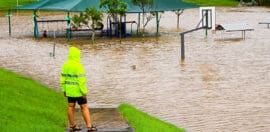Cross-sectors unite to make Melbourne greener

5 June 2019 at 5:19 pm
Melbourne has become the first city in Australia to launch a comprehensive strategy to increase and protect green urban spaces in a bid to dull the effects of climate change and protect the city’s most vulnerable.
Launched on World Environment Day by The Nature Conservancy Australia (TNCA) and Resilient Melbourne, the strategy maps where the highest and lowest areas of greenery are across the city, and what steps need to be taken to protect them.
The report said that until recently, cities existed in conflict with nature but attitudes were changing as people around the world recognised the many benefits of green cities.
“The success and long-term viability of cities depend on them being able to live alongside nature,” the report said.
“The urban forest cleans our air and water, reduces damaging heat in our neighbourhoods, and provides valuable habitat for flora and fauna.
“Exposure to nature reduces stress and the incidence of mental illness, and it provides opportunities to strengthen community bonds by providing spaces where people can congregate and recreate.”
The report recommended six actions to successfully roll out the plan, including protecting and restoring species habitat, setting targets and tracking progress, scaling up greening in the private sector, a toolkit of resources to help with implementation and fund the protection of the urban forest.
Dr James Fitzsimons, director of conservation at TNCA, said that changes in urban development, a fast-growing population, and climate change were all compromising the benefits of Melbourne’s urban forests.
“Cleaner air and water, reduced heat and habitat for wildlife are all affected by these factors,” Fitzsimons said.
“Melbourne’s highly valued tree cover is under threat.”
Maree Grenfell, acting chief resilience officer at Resilient Melbourne, told Pro Bono News that the report showed that the areas with less natural cover were where the most vulnerable people lived, and where the hottest parts of the city were.
“We know that we are really feeling the effects of climate change, specifically the heat waves in summer,” Grenfell said.
“So we really need to be able to cool the city down in a way that protects the people who are more vulnerable to heat.”
All 32 local councils, the state government, community organisations, and private partners have signed on to the strategy. Grenfell said that this level of collaboration was vital to the plan’s success.
“Councils are individually working towards improving their urban forest, but because we don’t have a metropolitan system of governance the efforts are disjointed,” she said.
“We are really encouraging a knowledge exchange so that councils who don’t have the resources and struggle with being able to lead in this area can learn and share from others.”
She also said they would work with residents on how to green up their own backyard.
“We know that property prices and property values are generally impacted in a positive way by greening,” she said.
“So we really want residents to get on board, not just to improve the quality of their life but to improve the biodiversity in their gardens.”
Grenfell said that no specific projects had been announced, but that all stakeholders in the project were enthusiastic to get started.
“We have got a lot of projects that people are really wanting us to be involved in,” she said.
The announcement comes a week after the state government and Melbourne City Council revealed 1 Treasury Place will be filled with greenery to demonstrate the environmental benefits of establishing green roofs across Melbourne.
The $2.7 million demonstration roof is expected to be completed by June 2020.









It would be wonderful if food growing formed part of this strategy. Where can we find out more?